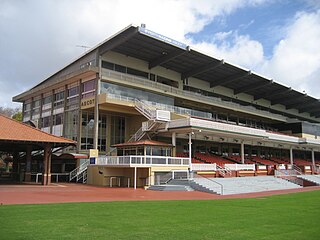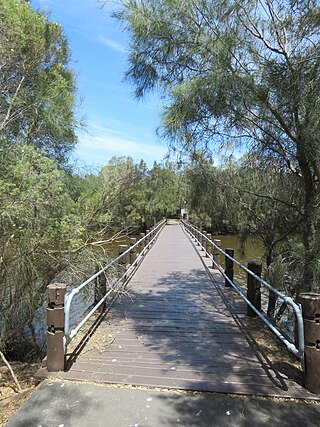
The Swan River is a major river in the southwest of Western Australia. The river runs through the metropolitan area of Perth, Western Australia's capital and largest city.

Albany is a port city in the Great Southern region in the Australian state of Western Australia, 418 kilometres (260 mi) southeast of Perth, the state capital. The city centre is at the northern edge of Princess Royal Harbour, which is a part of King George Sound. The central business district is bounded by Mount Clarence to the east and Mount Melville to the west. The city is in the local government area of the City of Albany. While it is the oldest colonial, although not European, settlement in Western Australia - predating Perth and Fremantle by over two years - it was a semi-exclave of New South Wales for over four years until it was made part of the Swan River Colony.

The City of Bayswater is a local government area in the Western Australian capital city of Perth, about 7 kilometres (4 mi) northeast of Perth's central business district. The city covers an area of 34.6 square kilometres (13.4 sq mi) and had a population of 69,283 as at the 2021 Census. The City of Bayswater is a member of the Eastern Metropolitan Regional Council.

Maylands is a riverside inner-city suburb approximately 4.5 kilometres (2.8 mi) northeast of Perth centred on the Midland and High Wycombe railway lines on the northern bank of the Swan River.

Ascot Racecourse is the major racecourse in Perth, Western Australia, situated approximately 8 kilometres (5.0 mi) east of the Perth central business district, with the headquarters of the Perth Racing positioned directly opposite.

Pemberton is a town in the South West region of Western Australia, named after original settler Pemberton Walcott.

York is the oldest inland town in Western Australia, situated on the Avon River, 97 kilometres (60 mi) east of Perth in the Wheatbelt, on Ballardong Nyoongar land, and is the seat of the Shire of York.

The Causeway is an arterial traffic crossing in Perth, Western Australia, linking the inner-city suburbs of East Perth and Victoria Park. It is carried over the Swan River at the eastern end of Perth Water by two bridges on either side of Heirisson Island. The current Causeway is the third structure to have been built across the river at this point.

Wesley College, informally known as Wesley, is an independent, day and boarding school for boys and girls, situated in South Perth, a suburb of Perth, Western Australia.

The All Saints Church in Henley Brook is the oldest church in Western Australia. It was built by Richard Edwards between 1838 and 1840, with the first service taking place on 10 January 1841. The site is on a small hill overlooking the Swan River and near the conjunction of the Swan and Ellen Brook. This site was where Captain James Stirling camped during his 1827 exploration of the area.

Wesley Church is a Uniting Church in Perth, Western Australia, located at the corner of William Street and Hay Street. It is one of the oldest church buildings and one of few remaining 19th-century colonial buildings in the City of Perth.

Wonnerup House is a heritage-listed farm precinct in Wonnerup, Western Australia. The current house was built in 1859 by George Layman Jr., one year after the original house built in 1837 by his father, George Layman Sr., was destroyed by fire. The dairy and kitchen survived the fire because they were separate from the house. Stables and a blacksmith workshop were later additions to the farm. In the 1870s, when the lack of a school in Wonnerup was an issue for the local residents, George Layman Jr. donated land near Wonnerup House for a school, which was built in 1873. In 1885 a teacher's house was constructed. The precinct was purchased by the National Trust of Australia in 1971 and opened to the public in 1973.

Maylands Airport on the Maylands Peninsula, in Maylands, Western Australia, was the main landing place of a significant number of record breaking flights in the early stages of flight in Australia. It was Perth's first official airport and was the birthplace of commercial aviation in Western Australia.
The National Trust of Western Australia, officially the National Trust of Australia (W.A.), is a statutory authority that delivers heritage services, including conservation and interpretation, on behalf of the Western Australian government and community. It is responsible for managing heritage properties and collections, as well as natural heritage management and education.

Garratt Road Bridge consists of two adjacent bridges over the Swan River, linking the suburbs of Bayswater and Ascot in Perth, Western Australia. The upstream bridge was built in 1935, while the matching downstream bridge was built in 1972. The site was significant prior to the construction of Garratt Road Bridge – it featured in Aboriginal mythology, and was in the near vicinity of 1880s bridges for pedestrians and trains. From that time there were various proposal to provide a vehicular crossing between Bayswater and Bassendean. Interest peaked in 1928, but plans were delayed due to the Great Depression. The first bridge, designed by Main Roads Chief Engineer Ernest Godfrey, was constructed in 1934–35. It allowed two lanes of traffic to cross the Swan River, alongside pedestrians on an adjacent footbridge.
Michael Clarkson was one of the early settlers in the Swan River Colony and the Avon region of Western Australia.

Kuljak Island, also known as Black Swan Island, is an artificial island in the Swan River. Situated between Ron Courtney Island upstream and Heirisson Island downstream, Kuljak Island is east of Maylands Peninsula and south of Garratt Road Bridge. Kuljak Island is surrounded by a number of smaller, also artificial, islets, and is entirely within the boundaries of the suburb of Ascot.

The Peninsula Hotel is a heritage-listed former hotel in Maylands, Western Australia. Located at 221 Railway Parade, opposite Maylands railway station, it was constructed c. 1906 by owner Friederich Liebe. The historic Edwardian-style hotel was saved from demolition in the 1970s, becoming a space for several community groups, and later a Dôme cafe.




















